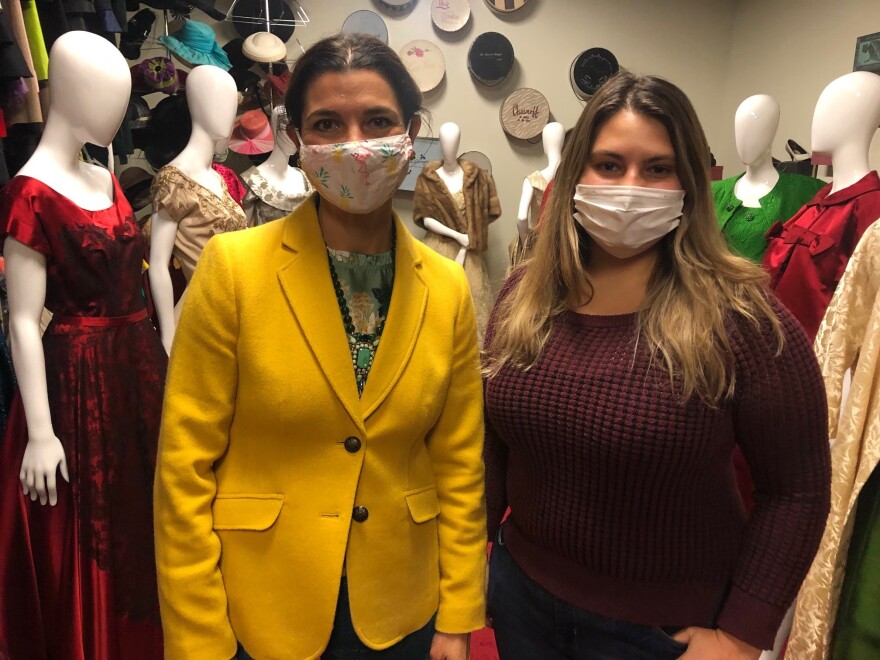Annie and Norton Rixey’s living room in Lake Waukomis, Missouri, is filled with boxes that contain programs, newspaper clippings, scrapbooks and photo albums.
“This is Mary Ellen,” said Annie, pointing to a framed photo. “And this was when she was the American Royal Queen. So we have a lot of queen stuff. There’s just copies and copies of the newspaper.”
Norton’s mom, Mary Ellen (Ash) Rixey, was the American Royal Queen in 1950. She went on to work for the Donnelly Garment Company in downtown Kansas City, Missouri, modeled Nelly Don clothes and designed fashion shows at regional department stores.

Mary Ellen married a cattle trader and moved to Fairway, Kansas, in 1957, where she raised two boys. She later specialized in medical records. But Norton said that staying trim and fashionable remained important to his mother.
“Have lipstick will travel,” he said with a laugh. “Red lipstick.”
When Mary Ellen died in 2019, the attic of her suburban home was stuffed, including rows of mothballed dresses from her 1950s fashion career. About a dozen dresses, including Nelly Dons, were donated to the historical fashion collection at Johnson County Community College (JCCC).
“She would be outstandingly happy that, first of all, some of these dresses could continue to be shown,” he said. “And, the fact that they will maybe be able to be kept for another 50 years, 80 years, 100, however long it takes.”

The fashion collection is housed in the Midwest Trust Center on the JCCC campus. The garments are arranged by designers on one side, and by decades, from the 1850s through the 1990s, on the other side.
“We have hats and shoes and we have probably, you know, 1500 to 2000 pieces,” said Britt Benjamin, fashion merchandising and design associate professor at JCCC.
She added, “I do like that we've left it for students to see and interact with it and didn’t really go super behind glass kind of situation.”
On a visit a few weeks ago, Benjamin walked up to about a dozen mannequins in a circle decked out in 1950s holiday fashion, ready to be transported to the Johnson County Museum.
“So this is Mary Ellen Rixey’s dress,” she said. “It's a burgundy taffeta with polka dot felt.”

There’s also a bright green satin dress with white fur cuffs and a red overcoat in heavy silk satin. The combination was a color palette for Kansas City women, who shopped at department stores such as Harzfeld’s, Woolf Brothers and Swanson’s.
Fashion in the 1950s, said Benjamin, turned away from the military silhouettes of the 1940s to what was called “the new look.”
“So the new look was Christian Dior's look after World War II,” she said, “which was big, full skirts, narrow waist, sloped shoulders."
Fashion design student Katelyne Kratofil previously studied 1950s furniture and interiors, but now she’s making connections to the fashions of the era.
“It’s a long, ankle-length floor line, blush pink taffeta gown. It’s got a really full skirt,” Kratofil said, as she described a dress designed by Martin Simon.
“This is really pretty, curved, it'd be considered a sweetheart neckline, with this really ornate, curved gold beading that kind of follows along that neckline. It's slightly off the shoulder. It’s gorgeous. I love it,” Kratofil exclaimed.

Many of these garments would have been worn at 1950s cocktail parties, attended by well-dressed friends and neighbors, and hosted in suburban homes — like the 1950s All-Electric House, the largest artifact in the Johnson County Museum’s collection.
“So the house was built in 1953 by the Kansas City Power and Light Company off of 63rd and Roe (in Prairie Village),” explained Anne Jones, curator of collections at the Johnson County Museum. “And it was a model home.”
The population of Johnson County, Kansas, boomed after World War II as families flocked to the suburbs and moved into newly built homes.
The All-Electric House showcased futuristic gadgets, such as a hidden television and a garage door opener.
“The American dream at that time was interpreted as having a home,” she said. “Owning your own home, in a neighborhood near good schools, good neighbors.”
During tours, Jones said, she also describes the dream versus reality since racially restrictive covenants segregated the Kansas City metro area.

In 2017, when the museum moved to the Arts and Heritage Center in Overland Park, it inspired a reimagining of the house.
“So the plan was instead of interpreting and furnishing it as that 1953-54 model home, we kind of redid the house, to support the story of how families lived here between, say 1955 and 1961,” she said. “Of course, the holidays are like the easiest thing to interpret in this house.”
But telling more stories required partnerships.
Earlier this year, the house celebrated Passover with the Overland Park temple B’nai Jehudah and Michael Klein's Judaica collection.
And 1950s holiday garments, cocktail dresses from the JCCC collection will be on display starting Nov. 20, throughout the house and on the front lawn.
“Not only do people get to see a different story,” she said, “They get to see a whole different set of objects that necessarily are not ours, but they're somebody else's that they may not see on a regular basis anywhere else.”
So whether it’s 1950s history, houses or clothes that intrigue you, a trip back in time this holiday season may be the perfect gift.
'Fashion Lights up the All-Electric House: Holiday Style,' Nov. 20, 2021 - Jan. 15, 2022, Johnson County Museum, Overland Park.





